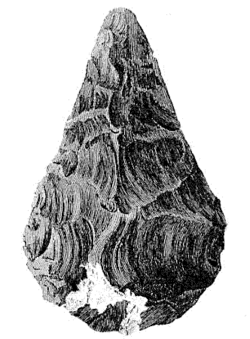John Frere


John Frere (10 August 1740 – 12 July 1807) was an English antiquary and a pioneering discoverer of Old Stone Age or Lower Palaeolithic tools in association with large extinct animals at Hoxne, Suffolk in 1797.
Life
Frere was born in Roydon Hall, Norfolk, the son of Sheppard Frere and Susanna Hatley. Ellenor Fenn was his sister.[2] In 1766, Frere received his MA from Gonville and Caius College, Cambridge, where he was Second Wrangler and was elected to a fellowship.[3]
He subsequently held several political offices and was appointed High Sheriff of Suffolk for 1776–77. He was elected a member of parliament for Norwich from 1799 to 1802.[4]
Antiquary
An interest in the past, instigated by observing worked stone tools in a clay mining pit, led him to become a Fellow of the Society of Antiquaries of London and the Royal Society and to conduct excavations at a site just south of Hoxne, 8 km east, and across the River Waveney, from his home in Roydon, near Diss. Frere wrote a letter to the Society of Antiquaries about flint tools and large bones of extinct animals found at a depth of approximately twelve feet (four meters) in a hole dug by local brickworkers. He described the worked stones as "...weapons of war, fabricated and used by a people who had not the use of metals... The situation in which these weapons were found may tempt us to refer them to a very remote period indeed, even beyond that of the present world...." In addition, Frere carefully described the stratigraphy of the find, with the tools lying below an apparent ancient sea floor, yet not in a position to which they could have been washed down. Although Frere's letter was officially read at the Society on 22 June 1797, and published by it in 1800, his interpretation was so radical by the standards of the day as to be overlooked for six decades, until noticed by John Evans.[5][6]
Frere's is considered one of the most important middle Pleistocene sites in Europe, because of what he observed in his letter: juxtaposition of artefacts, animal remains and stratigraphic evidence. Its significance is double: for paleoanthropology, showing Homo presence in Britain approximately 400,000 years ago, and, for geology, dating stages of the European Great Interglacial period (known in Britain as the Hoxnian).[7]
Family
Frere married Jane Hookham, daughter of John Hookham, on 12 June 1768. John Hookham Frere was their eldest son.[3] Their second son Edward was manager of Clydach Ironworks and the father of Sir Henry Bartle Frere, 1st Baronet.[2] The fourth, fifth and sixth sons were William Frere, Bartholomew Frere, and James Hatley Frere. Their youngest son, Temple (b. 1781), was for 20 years canon of St Peters, Westminster, and rector and curate of the round-towered St Remigius, Roydon (near Roydon Hall), whose plaques give testimony to members of their large family, including a later Temple, who "drowned when saving the life of a fellow-student", in 1840, aged 22. Besides their seven sons they had two daughters, including Susanna (1778–1839).
Notes and references
- ↑ Frere, John:
 "Account of Flint Weapons Discovered at Hoxne in Suffolk"., in Archeologia, vol. 13.- London, 1800.- Pp. 204–205
"Account of Flint Weapons Discovered at Hoxne in Suffolk"., in Archeologia, vol. 13.- London, 1800.- Pp. 204–205 - 1 2 thepeerage.com John Frere
- 1 2 "Frere, John (FRR758J)". A Cambridge Alumni Database. University of Cambridge.
- ↑ "FRERE, John (1740–1807), of Roydon Hall, Norf. and Finningham, Suff.". History of Parliament Online. Retrieved 20 June 2013.
- ↑ See Ronald Singer et al., The Lower Paleolithic Site at Hoxne, England (University of Chicago Press, 1993) for the letter, Evans find and later investigations and evaluations of the site, also paleoanthropologist Mary Leakey, Disclosing the Past: An Autobiography, Garden City, New York: Doubleday, 1984, p. 15. (Leakey was a direct descendant of John Frere through her mother, Cecilia Marion Frere.)
- ↑ Antiquarian John Frere/ Freer Family Genealogy Research includes the text of Frere's "Letter to The Rev. John Brand, Secretary, Read June 22, 1797".
- ↑ Chris Stringer, Homo Britannicus (Penguin, 2006), p. 84.
- Robert Beatson, A Chronological Register of Both Houses of Parliament (London: Longman, Hurst, Res & Orme, 1807)
 Stephen, Leslie, ed. (1889). "Frere, John (1740-1807)". Dictionary of National Biography. 20. London: Smith, Elder & Co.
Stephen, Leslie, ed. (1889). "Frere, John (1740-1807)". Dictionary of National Biography. 20. London: Smith, Elder & Co. - Leigh Rayment's Historical List of MPs
External links
-
 Works written by or about John Frere at Wikisource
Works written by or about John Frere at Wikisource - Information on Frere and his relatives
- Stone tools excavated by Frere
| Parliament of Great Britain | ||
|---|---|---|
| Preceded by William Windham Hon. Henry Hobart |
Member of Parliament for Norwich 1799– 1800 With: William Windham |
Succeeded by Parliament of the United Kingdom |
| Parliament of the United Kingdom | ||
| Preceded by Parliament of Great Britain |
Member of Parliament for Norwich 1801– 1802 With: William Windham |
Succeeded by Robert Fellowes William Smith |